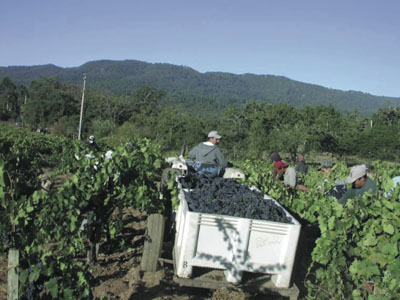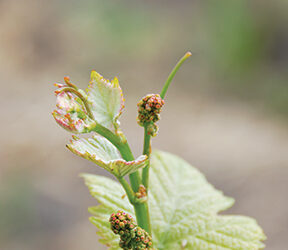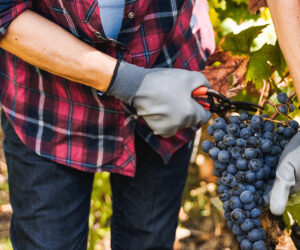 One of my favorite Chinese proverbs is: “Many hands make light work.” It’s as true in the vineyard as anywhere. The vineyard is a place that traditionally brings people together — to till the Earth, to connect us to the natural world, to bind us to the movement of the seasons and, of course, to gather at the table to share the fermented fruits of our labor.
One of my favorite Chinese proverbs is: “Many hands make light work.” It’s as true in the vineyard as anywhere. The vineyard is a place that traditionally brings people together — to till the Earth, to connect us to the natural world, to bind us to the movement of the seasons and, of course, to gather at the table to share the fermented fruits of our labor.
Managing labor in the vineyard can be as easy as scheduling one morning a weekend during the growing season for checking on the vineyard and administering its maintenance. With larger vineyards, more than a row or two, you may need to enlist some help. For many reasons, friends are the best solution. You get to spend time with them and bond through some hard work, and then eat and drink afterwards. You may not need a reason to have a small lunch celebration, but finishing some work in the vineyard is always a good excuse to throw down a few old bottles with some cheese and salami.
Determining your labor needs
If you remember one thing from this article, remember this: daily walks through the vineyard will do more for your management than any single practice. Knowing the status of the vineyard is vital. Before you start hiring or asking friends to help, it’s key to know what needs to be done and how critical the timing is. Ninety percent of vineyard problems start with a lack of observation. Whoops, there’s mildew everywhere! How did this vineyard get so overgrown? Why are the weeds six feet high? I was supposed to water? Early season labor attempts to solve problems before they can arise, so the more you get done early, the less you’ll have to do later.
One full-time worker (40–48 hours a week) can take care of up to one acre by hand or up to five acres with the proper commercial tractor and professional tools. This includes all major and minor cultural practices, as defined in the next section of the article. So let’s do some math: Assume that you do your home vineyard farming by hand. One person working one acre 40 hours a week means a yearly labor total of about 2,000 hours per acre. This may seem excessive, but without commercial farming equipment, everything needs to be done by hand (spraying, weed control, canopy manipulation). Hand labor is superior in many ways to mechanical, and hand labor minimizes reliance on chemical applications.
You can expect to put in about 1.25 hours of labor per vine in your vineyard per year. The problem is you can’t space that work out evenly throughout the calendar. A line graph of required vineyard labor would show spikes in December–January (pruning), spring (shoot removal and positioning), early summer (hedging, leafing) and during fall (harvest). Keeping this in mind, you may want to plan yearly vacations accordingly: After crush and between finishing pruning and budbreak are always good times to get away and drink wines in a fresh locale! Here’s a break down of basic yearly work:
Winter:
Plant and maintain a cover crop in areas that are warm enough. Plant grasses and crops that will protect hillsides from erosion and that add missing nutrients to the soil. If the cover crop gets too wild and woolly, mow it, and if possible, cultivate the vineyard to bare soil before budbreak to minimize frost damage.
Pruning (including the actual cutting, cleaning up, wrapping and tying of the canes to the wire in a cane-pruned system): Spur-pruned vines take about one-fifth the time to prune, as decisions are minimized. If you are required to hire and train pruning help, spur-pruned vines with permanent cordon arms are the only way to go. Cane-pruning should only be done by experienced professionals, as the tasks of choosing the correct fruiting canes and developing a head and renewal spurs require a high level of expertise.
Pruning carefully (2-4 minutes a vine) will add up to around 50–75 hours per acre of labor. Spur pruning by an experienced crew can take that down to 15–30 hours per acre. Pruning is not the time to skimp on labor and training. The way your vines are pruned will set the quality foundation for the entire vintage, and will impact the vine’s fruitfulness for years to come. Expect one good worker to prune one acre per week (40 acres) if spur trained, two weeks if the vineyard is cane pruned.
In severe drought years, start watering at least a month before budbreak, up to 100 gallons (380 L) or more per plant over a few weeks to saturate the soil profile. With adequate rainfall over winter, say over 15 inches (38 cm), you will likely not have to water until late spring.
Early to mid spring:
Spring is where the vintage is made in the vineyard. Expect to be busy every week or to hire someone to take care of the vineyard as it begins to grow a canopy and hang a crop. At budbreak (before 6 inches or 15 cm of growth), start laying down fungicide sprays, which for most of you will be sulfur or a sulfur/copper blend. Some regions will require weekly sprayings, others every few weeks — check with local nurseries for recommendations and stick to your spray schedule with military precision. Nothing can ruin a vintage more quickly than a bad mildew or rot infection. If you can afford an ATV or even a tractor sprayer, lay out the dough. The key here is sticking to a schedule and getting enough pressure for adequate coverage. Most times when I’m called to consult at a vineyard with mildew problems, the owners tried to use backpack sprayers and got terrible coverage. Also at budbreak you need to knock all the suckers (basal shoots) off of the base and trunk of your vines. Suckers are a nutrient sink and need to be removed before becoming woody. If there’s green poking out anywhere but on the fruiting wire, knock it off! I like to use a heavy glove and rub the trunk of the vine in a clinched fist. You’ll not only get the growing suckers, but also those soft little red “thorn buds” that will be suckers within a week.
Shoot removal: As the shoots begin to grow, you need to decide how many growing shoots you want to retain on the vines, and how many to remove. Most growers choose an exact number, say 4–5 shoots per foot (~30 cm) of fruiting wire. So if you have vines spaced 4 feet (1.2 m), that’s 20 shoots per plant, or maximum of 10 per side. The easy way to do this is to use a closed fist’s span between each plant, which is about 4 inches (10 cm). The key here is to reduce shoot crowding. So, remove the smaller shoot from “double shoots” and get those growing shoots spaced out so the fruit does not nest when it grows. Each cluster and shoot needs its own niche space on the trellis. This way light and wind can penetrate the canopy and keep the fruit clean and increase efficacy of spray applications.
Late spring/early summer:
Position shoots into a vertical position using the upper wires in your trellis system (if you are using a vertical shoot positioning system). Once the clusters go through flowering and set, remove just enough leaves around the clusters that the fruit gets good sun exposure but does not burn or raisin. You may need to experiment with leaf pulling regimens before you get the right look and flavor. Monitor soil moisture and give the vines ample water to grow moderate foliage.
Once the canopy is the desired size, you can dry out the roots until the vine shifts from growing vegetatively to focusing on the fruit ripening. Hedge the tips of your vines if necessary, but realize by doing so the vine will respond by pushing lateral shoots, which will have to be removed.
Summer and harvest:
Net the vines when the fruit softens and changes color and stop spraying sulfur. If mildew pressure persists, look for another fungicide besides sulfur, as late sulfur sprays can put elemental sulfur in your wine. Observe the fruit often for holes in the nets, critter thieves, bees, hornets and you may want to do one last vineyard cleanup to make harvest easy: Mow tall grasses, do one last leaf pulling and hedging. Test the fruit as it ripens and get all of your harvest and winemaking gear sanitized, gleaming and ready. Call your friends and harvest really early in the morning to get the fruit into the winery cold.
Training vineyard workers
Go pro: I have kept the same vineyard crew for 11 years, and not having to retrain my crew every year is a blessing. Keeping the same hands working on the same vines is precious. Consistency and fine tuning vineyard practices are what make great wines, so if you can find a labor source that is dependable and long-lived, do whatever you can to secure that labor permanently. If you can make friends with a vineyard manager, you may be surprised how readily he or she will “rent out” the crew for a few days, especially during slow times. Don’t expect to find a single soul available during pruning and harvest, but in between there is likely a labor contractor looking to place a vineyard crew. The farther you live from commercial vineyards, the less chance you have of finding a laborer with experience, so you may need to travel to a big vineyard, offer to work for free, get some training, and apply it to those folks doing the work at your vineyard.
Family and friends: Make a schedule for getting work done and then invite friends and family to come help with the vineyard. Make a nice invitation, make it sound romantic and offer food and wine after the work is done. Invite various folks each time to keep the crew fresh, and to avoid burning out your workers.
Make jokes after the first few hours of sweat how “romantic” pruning or shoot positioning is. Don’t skimp on the vino, but don’t allow drunk people to use pruning shears or a weed whacker. Offer cotton gloves and eye protection, as a lawsuit will likely bring an end to the fun.
Checking the work: When a new crew or friends start a practice in the vineyard it is absolutely vital that you watch them work for a few hours, and school them on proper technique. I find that after a few hours of doing a specific task in the vineyard I go on “autopilot” and start thinking about last night’s Sopranos or a nice plate of carnitas. The key here is to make sure the workers are perfectly trained before they go into autopilot, or they could cause more harm than good to the vines. Start with a “gather around and let me show you what to do” session, and then spend as much time as necessary watching the crew until you are convinced they are all on the same page. Crews generally will respect you if you are willing to put in just as much work as you expect from them. In other words, sitting under a shade umbrella with a chilled glass of Sauvignon Blanc while barking out orders from the sidelines may not thrill the crew.
Correlating labor with wine quality: In conclusion, it is important for vineyard labor to be completed early and consistently with an emphasis on daily vineyard observation. Make an effort to sustain the same labor force from year to year and you will find that the time spent training will become time spent on fine tuning the practices according to the quality and assessment of the previous year’s vintage. Remember to share your passion with those working in the vineyard.







